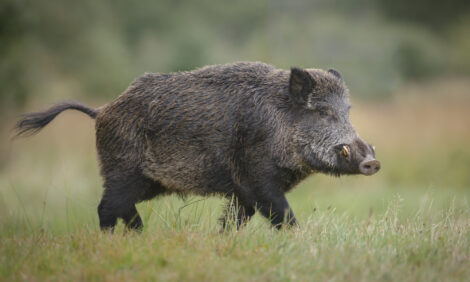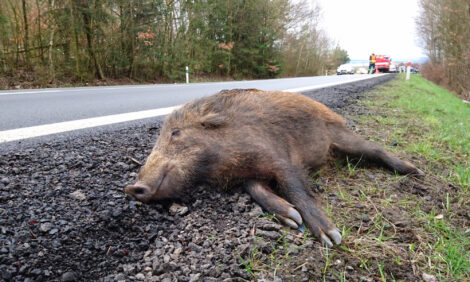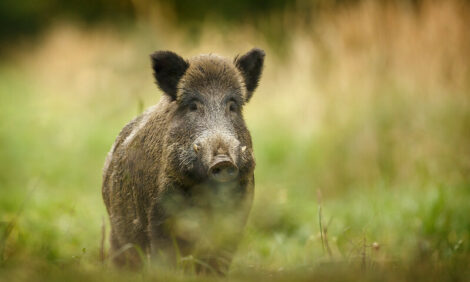



African swine fever in wild boar: secondary spread of ASF virus
Role of different matrices for the secondary spread of ASFEditor's note: the following is an excerpt from African swine fever in wild boar populations - ecology and biosecurity. It was created by the FAO, WOAH and European Commission. Additional content from the booklet will be shared as an article series.
Oral-nasal excretions/secretions
The virus is present in both the nasal and the oral secretions of infected animals, and can be detected even before its appearance in blood and clinical signs. These oral and nasal fluids are likely to be involved in the direct contact spread of the infection. The quantity of shed virus is relatively low, though sufficient to trigger new infections. In the oral and nasal fluids, the virus is shed for a number of days (2–4), while its half-life is not known. The more the clinical phase progresses, the more virus is excreted, especially towards the end of the animal’s life when mortality is brought on by the infection.
Blood
The virus can be detected at very high titre in the blood of infected wild boar at 2–5 days (on average, 3 days) after infection; its detection is concomitant with the onset of clinical signs, and can survive for up to 100 days in convalescent animals. The virus in the blood can survive for 15 days at room temperature, months at 4 °C and indefinitely when frozen. The blood contamination of soil, hunting premises and tools, including knives, clothes and cars used for transport of infected hunted animals, are important sources for the local persistence and further spread of the virus.
Raw meat
The virus is also present in the meat from infected animals, which represents an important source for both the local maintenance and long-distance spread of the virus. Since the virus is resistant to putrefaction, it can survive for more than 3 months in meat and offal. It remains infectious for almost one year in dry meat and fat, and it survives indefinitely in frozen meat. The frozen meat of infected wild boar can ensure the survival of the virus for years, and thus represents a possible source for new epidemics.
Carcasses and offal
The ASFV outlives its host. As in meat, the virus can survive in entire carcasses or offal for a very long time, depending on ambient temperatures, organs or tissues. A frozen carcass can maintain infectious virus for months, which means that the pathogen can overwinter even in the temporary absence of any live host and initiate a new transmission cycle when the defrosted carcasses are approached the following spring by susceptible wild boar. In the ecology of ASF in wild boar, the virus’s survival in carcasses plays a crucial role. Once an infected wild boar dies, the virus remains infectious in the carcass for an extended period of time. Safe removal of carcasses from the environment and their disposal is thus among the most important disease control measures, without which ASF eradication from wild boar populations is not possible. Similarly, if infected animals are hunted and dressed in the field, the offal (including viscera, skin, head and other parts of the body) also becomes an important potential source of the virus. Particularly in winter, when most hunting activities take place, offal that has not been properly disposed has the potential to increase the risk of secondary infections and the further spread of the disease. The genome of the virus can also be detected in buried carcasses, but the virus is no longer infectious. The soil on which an infected wild boar dies and its carcass then lies, is also likely to be contaminated, and thus has to be considered as a source of live virus for at least two weeks following the removal of the carcass (Carlson et al., 2020).
Faeces and urine
Both faeces and urine are infectious, and the halflife of the virus is determined by the environmental temperature. ASFV survives longer in urine than in faeces. Its half-life in urine ranges from 15 days at 4 °C to 3 days at 21 °C. In faeces, virus half-life ranges from 8 days at 4 °C to 5 days at 21 °C, and the virus DNA is still detectable from two to four years (de Carvalho Ferreira et al., 2014). Davies et al. (2017) have demonstrated that the virus is still infectious in urine and faeces after five days. It is important to underline that the half-life of the virus is strongly affected by enzymes (proteases and lipases) produced by the bacteria which colonize faeces and urine; thus, the exact survival time in a forest where ASF is actively circulating is not fully comparable to the estimates obtained under laboratory conditions. However, in areas highly contaminated by infected faeces and urine, the risk of secondary spread of the virus will be more likely, through vectors such as contaminated boots, tyres or hunting tools. At feeding stations visited by many animals, contamination by infected faeces or urine could increase the rate of secondary infections.
Soil
As already mentioned, viral DNA has been detected in the soil after the removal of the body of an infected wild boar or when the soil is contaminated by infected blood or other excretes-secretes. Laboratory experiments show that the pH of the soil (which reflects the amount of organic material), the temperature, initial virus titration, amount of virus contamination and the source matrix that contaminated the soil all affect the lifespan of the virus, and thus its infectious period (Carlson et al., 2020).
Scavenging insects
It has been hypothesized that ASFV can potentially survive in insects (adult and larval stages) scavenging on infectious carcasses. However, while maggots of the green bottle fly (Lucilla sericata) and blue bottle fly (Calliphora vicina) have been detected as contaminated with ASF DNA, the presence of viable ASFV could not be proven (EFSA, 2010a; Forth et al.,
2018). It is not known if the virus maintains its infectivity in other scavenging invertebrates. In any case, scavenging insects are attractive food for wild boar, thus increasing the contact rates between infectious carcasses and susceptible wild boar.
Hematophagous arthropods
The stable fly (Stomoxys calcitrans) is considered a potential mechanical vector of the virus, which it is capable of carrying for 48 hours (Mellor, Kitching and Wilkinson, 1987), but their role in the transmission cycle in Europe has not yet been fully investigated. The role played by other blood-feeding arthropods is unclear too, especially in the wild. Ornithodoros ticks,
strongly involved in the natural ASF transmission cycle in Africa, do not occur in the parts of the European continent currently affected by ASF. In a heavily infected area with high virus prevalence in wild boar and in the absence of infected pigs, all the tested ticks (genus Ixodes), midges (genus Culicoides) and horseflies or tabanids were ASFV negative despite the PCR tests proving they fed on suids (Herm et al., 2021).
Fomites
The high environmental resistance of the virus implies that its transmission is possible via any fomite, (non-living objects capable of carrying infectious organisms when contaminated), such as shoes, clothing, parts of vehicles, knives and other kinds of equipment.
Food/kitchen waste
The high resistance of the virus means that thermally untreated food originating from infected animals (both domestic pigs and wild boar), such as sausages, salami or ham, as well as food leftovers accidentally released into a wild boar habitat, can initiate an ASF epidemic. It is well known that food waste is considered the main source of the virus in the long-distance
spread of ASF.
Grass and other growing crops
Infected wild boar could contaminate grass and other growing crops, such as corn plants, intended for use as feed by other animals when harvested. Therefore, feeding grass or unprocessed vegetables to domestic pigs should be forbidden everywhere that ASF is present in wild boar populations.
Reference
Guberti, V., Khomenko, S., Masiulis, M. & Kerba S. 2022. African swine fever in wild boar – Ecology and biosecurity. Second edition. FAO Animal Production and Health Manual No. 28. Rome, FAO, World Organisation for Animal Health and European Commission. https://doi.org/10.4060/cc0785















